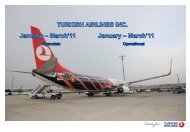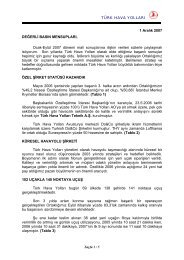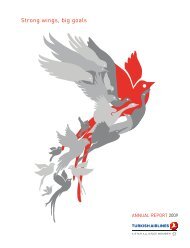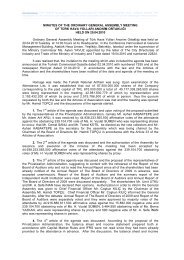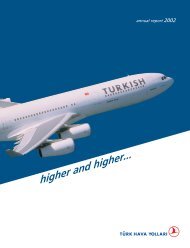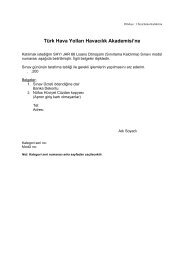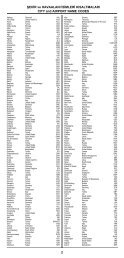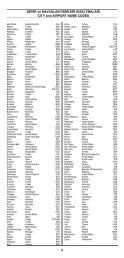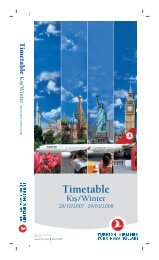Financial - Turkish Airlines
Financial - Turkish Airlines
Financial - Turkish Airlines
- No tags were found...
You also want an ePaper? Increase the reach of your titles
YUMPU automatically turns print PDFs into web optimized ePapers that Google loves.
(Convenience Translation of Report and <strong>Financial</strong> Statements Originally Issued in <strong>Turkish</strong>)TÜRK HAVA YOLLARI ANONİM ORTAKLIĞI AND ITS SUBSIDIARIESNotes to the Audited Consolidated <strong>Financial</strong> StatementsFor the Year Ended 31 December 2012(All amounts are expressed in <strong>Turkish</strong> Lira (TL) unless otherwise stated.)The Group management anticipates that the application of IFRS 9 in the future may not have significant impact onamounts reported in respect of the Group’s financial assets and financial liabilities.New and revised Standards on consolidation, joint arrangements, associates and disclosuresIn May 2011, a package of five Standards on consolidation, joint arrangements, associates and disclosures was issued,including IFRS 10, IFRS 11, IFRS 12, IAS 27 (as revised in 2011) and IAS 28 (as revised in 2011).Key requirements of these five Standards are described below.IFRS 10 replaces the parts of IAS 27 Consolidated and Separate <strong>Financial</strong> Statements that deal with consolidatedfinancial statements. SIC-12 Consolidation - Special Purpose Entities will be withdrawn upon the effective date of IFRS10. Under IFRS 10, there is only one basis for consolidation, that is control. In addition, IFRS 10 includes a new definitionof control that contains three elements: (a) power over an investee, (b) exposure, or rights, to variable returns from itsinvolvement with the investee, and (c) the ability to use its power over the investee to affect the amount of the investor’sreturn. Extensive guidance has been added in IFRS 10 to deal with complex scenarios.IFRS 11 replaces IAS 31 Interests in Joint Ventures. IFRS 11 deals with how a joint arrangement of which two or moreparties have joint control should be classified. SIC-13 Jointly Controlled Entities - Non-monetary Contributions byVenturers will be withdrawn upon the effective date of IFRS 11. Under IFRS 11, joint arrangements are classified as jointoperations or joint ventures, depending on the rights and obligations of the parties to the arrangements. In contrast,under IAS 31, there are three types of joint arrangements: jointly controlled entities, jointly controlled assets andjointly controlled operations. In addition, joint ventures under IFRS 11 are required to be accounted for using the equitymethod of accounting, whereas jointly controlled entities under IAS 31 can be accounted for using the equity method ofaccounting or proportional consolidation.IFRS 12 is a disclosure standard and is applicable to entities that have interests in subsidiaries, joint arrangements,associates and/or unconsolidated structured entities. In general, the disclosure requirements in IFRS 12 are moreextensive than those in the current standards.In June 2012, the amendments to IFRS 10, IFRS 11 and IFRS 12 were issued to clarify certain transitional guidance onthe application of these IFRSs for the first time.These five standards together with the amendments regarding the transition guidance are effective for annual periodsbeginning on or after 1 January 2013, with earlier application permitted provided all of these standards are appliedat the same time. The Group management anticipates that the application of these five standards may not have anysignificant impact on amounts reported in the consolidated financial statements.IFRS 13 Fair Value MeasurementIFRS 13 establishes a single source of guidance for fair value measurements and disclosures about fair valuemeasurements. The Standard defines fair value, establishes a framework for measuring fair value, and requiresdisclosures about fair value measurements. The scope of IFRS 13 is broad; it applies to both financial instrument itemsand non-financial instrument items for which other IFRSs require or permit fair value measurements and disclosuresabout fair value measurements, except in specified circumstances. In general, the disclosure requirements in IFRS13 are more extensive than those required in the current standards. For example, quantitative and qualitative disclosuresbased on the three-level fair value hierarchy currently required for financial instruments only under IFRS 7 <strong>Financial</strong>Instruments: Disclosures will be extended by IFRS 13 to cover all assets and liabilities within its scope.13



